Слайд 2Translation
Translation- is a transfer of meaning across cultures.
More specifically, translation is

the process and the result of creating in a target, or translating, language (TL) a text which has approximately the same communicative value as the corresponding text in the source language (SL).
Слайд 3The aim of translation
The aim of translation: to produce the text or

message in the TL which is equivalent to the original text or message in the SL both semantically and pragmatically.
In translation we deal with two languages (two codes) and to verify the info they give us about the extralinguistic objects we should consider extralinguistic situation, and background information.
Слайд 4Basic assumptions
This target text (TT, that is the translation) is not fully

identical with ST as to its form or content due to the limitations imposed by the formal and semantic differences between the source language (SL) and TL.
Слайд 5Basic assumptions
The ideal translation should be accurate as to meaning and natural

as to the receptor language forms used.
An intended audience who is unfamiliar with the source text will readily understand it.
The success of a translation is measured by how closely it measures up to these ideals.
Слайд 6Object of the science
As any observable phenomenon, translation can be the

object of scientific study aimed at understanding its nature, its components and their interaction as well as various factors influencing it or linked with it in a meaningful way.
The science of translation or translatology is concerned both with theoretical and applied aspects of translation study.
Слайд 7Basic assumptions
The ideal translation should be…
Accurate: reproducing as exactly as possible the

meaning of the source text.
Natural: using natural forms of the receptor language in a way that is appropriate to the kind of the text being translated.
Communicative: expressing all aspects of the meaning in a way that is readily understandable to the intended audience.
Слайд 8Translation components
Translation is an entity consisting of the interrelated components:
1) elements and

structures of the ST;
2) elements and structures of the TT;
3) transformation rules to transform the elements and structures of the ST into the TT;
Слайд 9Translation components
4) systems of the languages involved in translation;
5) conceptual content and

organization of the ST;
6) conceptual content and organization of the TT;
7) interrelation of the conceptual contents of the ST and TT.
Слайд 10Participants
There are at least 3 participants involved in translation process:
the sender (source),
the

translator who acts in dual capacity as the recipient of the SL message and as the sender of the equivalent TL message,
the recipient of the TL message of the translated version.
Слайд 12Phases of Translation
Translation as an interlingual communicative act includes two phases:

Слайд 13Operations in the process of translation
1) the translator deduces the TL elements
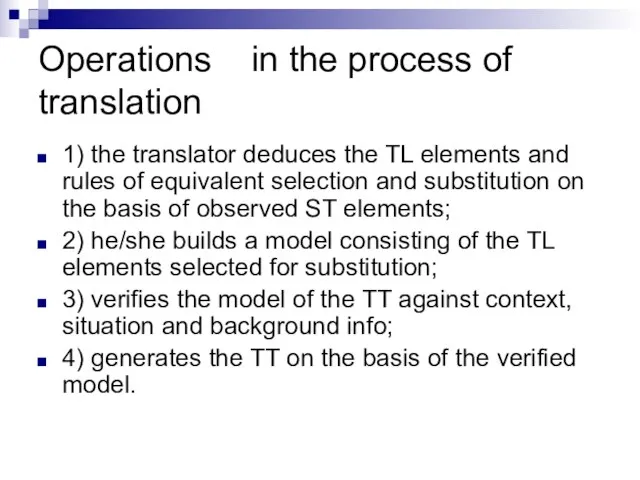
and rules of equivalent selection and substitution on the basis of observed ST elements;
2) he/she builds a model consisting of the TL elements selected for substitution;
3) verifies the model of the TT against context, situation and background info;
4) generates the TT on the basis of the verified model.
Слайд 14The process of translation
Three stages:
a) analysis of the ST, situation and background
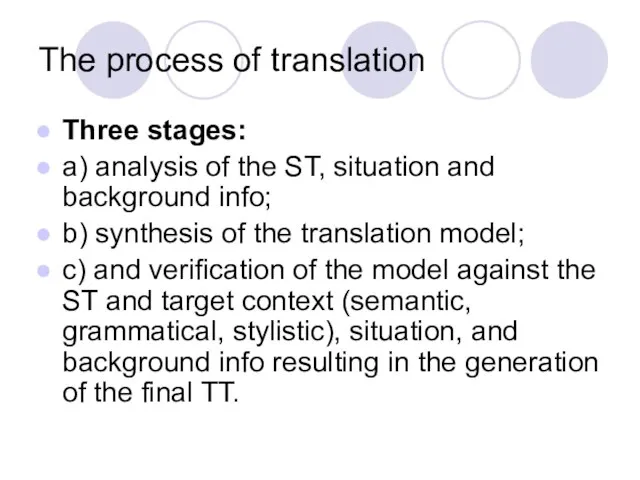
info;
b) synthesis of the translation model;
c) and verification of the model against the ST and target context (semantic, grammatical, stylistic), situation, and background info resulting in the generation of the final TT.
Слайд 15Aspects of translating process (TP)
Psychologically viewed, the TP includes 2 mental processes
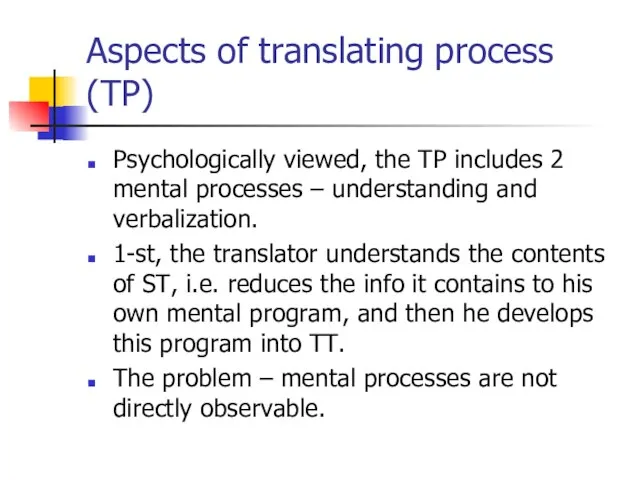
– understanding and verbalization.
1-st, the translator understands the contents of ST, i.e. reduces the info it contains to his own mental program, and then he develops this program into TT.
The problem – mental processes are not directly observable.
Слайд 16Aspects of translating process (TP)
Translation models.
A model is a conventional representation of
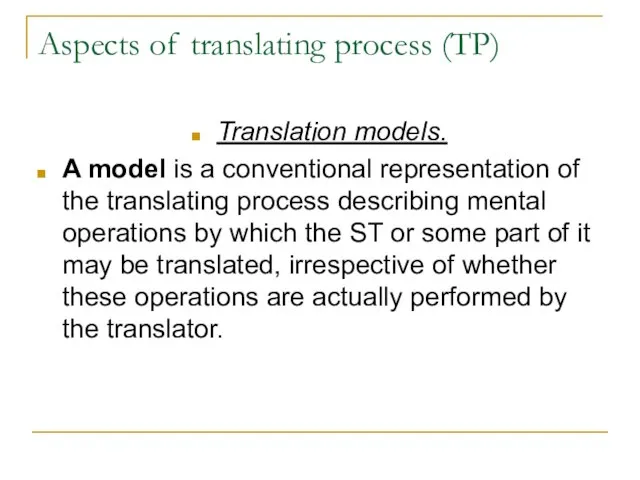
the translating process describing mental operations by which the ST or some part of it may be translated, irrespective of whether these operations are actually performed by the translator.
Слайд 17Aspects of translating process (TP)
There are such models of translating process: 1)
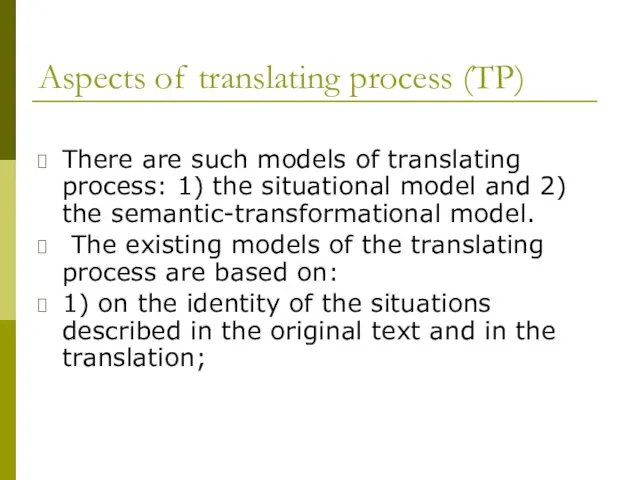
the situational model and 2) the semantic-transformational model.
The existing models of the translating process are based on:
1) on the identity of the situations described in the original text and in the translation;
Слайд 18Aspects of translating process (TP)
2) is based on the similarity of basic
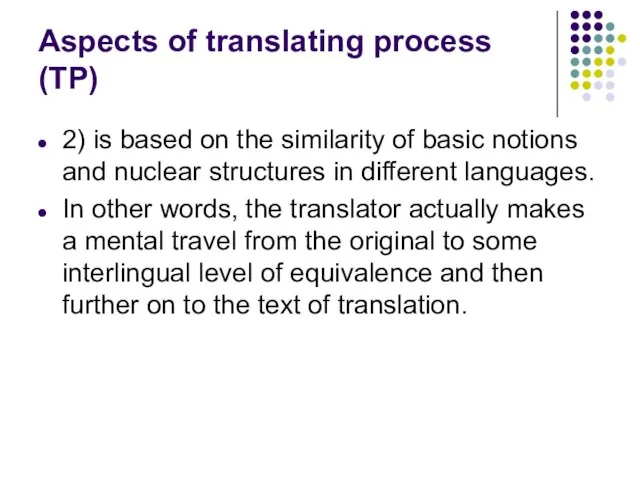
notions and nuclear structures in different languages.
In other words, the translator actually makes a mental travel from the original to some interlingual level of equivalence and then further on to the text of translation.
Слайд 19Aspects of translating process (TP)
Situational model
The process goes from the text in
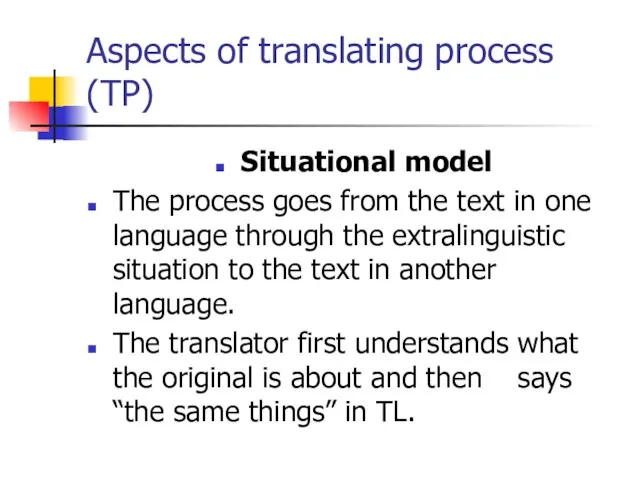
one language through the extralinguistic situation to the text in another language.
The translator first understands what the original is about and then says “the same things” in TL.
Слайд 20Aspects of translating process (TP)
“Manson walked quickly down the platform, searching eagerly
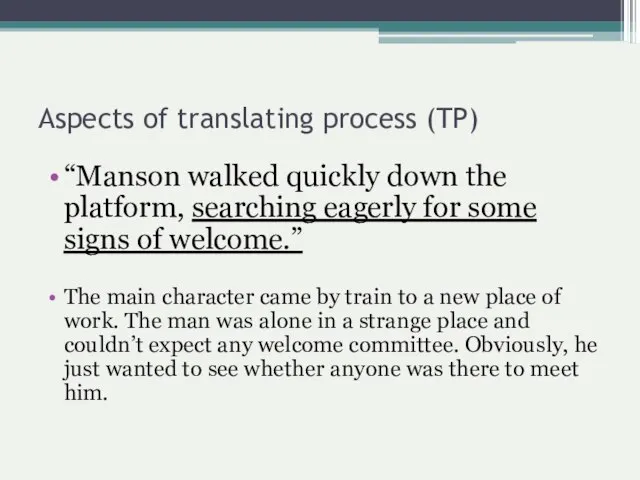
for some signs of welcome.”
The main character came by train to a new place of work. The man was alone in a strange place and couldn’t expect any welcome committee. Obviously, he just wanted to see whether anyone was there to meet him.
Слайд 21Aspects of translating process (TP)
«Мэнсон быстро прошел по перрону, оглядываясь, не встречает
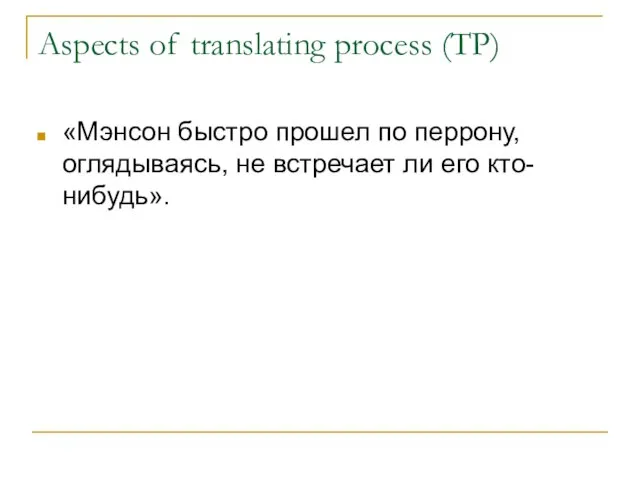
ли его кто-нибудь».
Слайд 22Aspects of translating process (TP)
Semantic-transformational model
This model postulates the existence of the
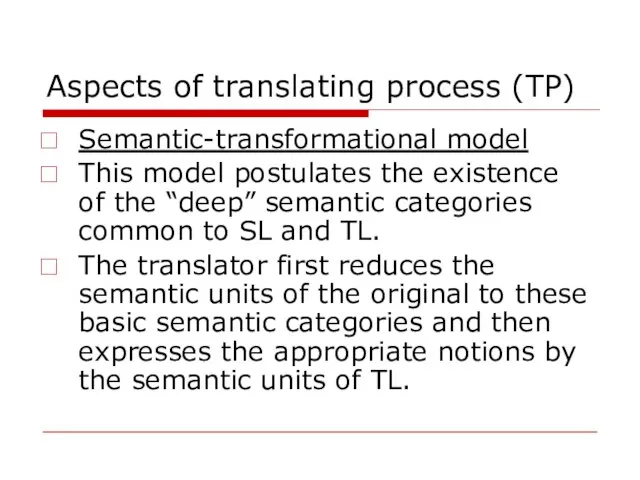
“deep” semantic categories common to SL and TL.
The translator first reduces the semantic units of the original to these basic semantic categories and then expresses the appropriate notions by the semantic units of TL.
Слайд 23Aspects of translating process (TP)
“John is the proud owner of the new
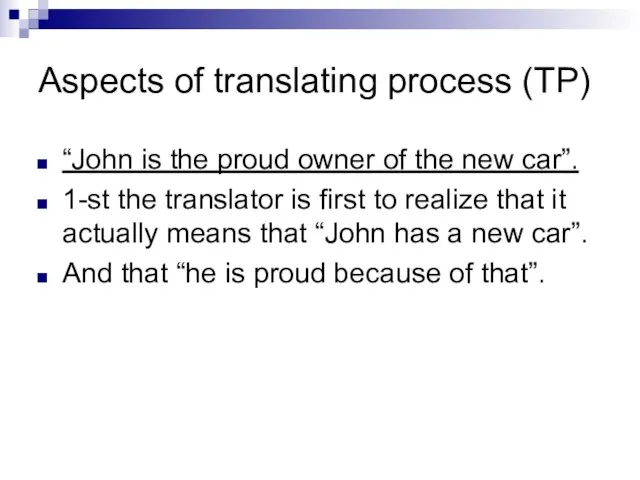
car”.
1-st the translator is first to realize that it actually means that “John has a new car”.
And that “he is proud because of that”.
Слайд 24Aspects of translating process (TP)
«У Джона (есть) новая машина, которой он очень
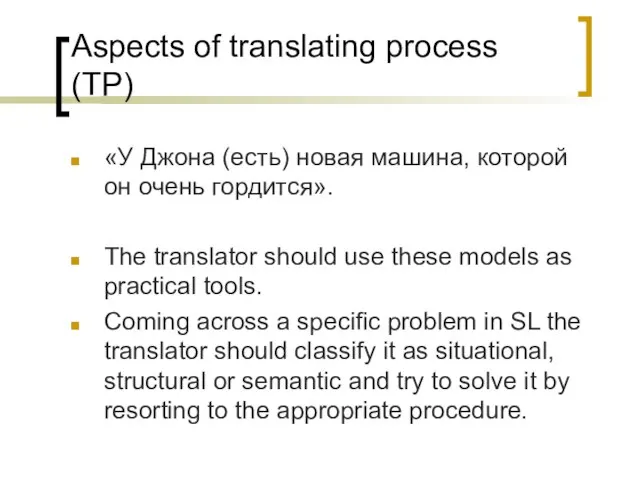
гордится».
The translator should use these models as practical tools.
Coming across a specific problem in SL the translator should classify it as situational, structural or semantic and try to solve it by resorting to the appropriate procedure.
Слайд 25Aspects of translating process (TP)
“He is a poor sleeper”.
An attributive group can’t
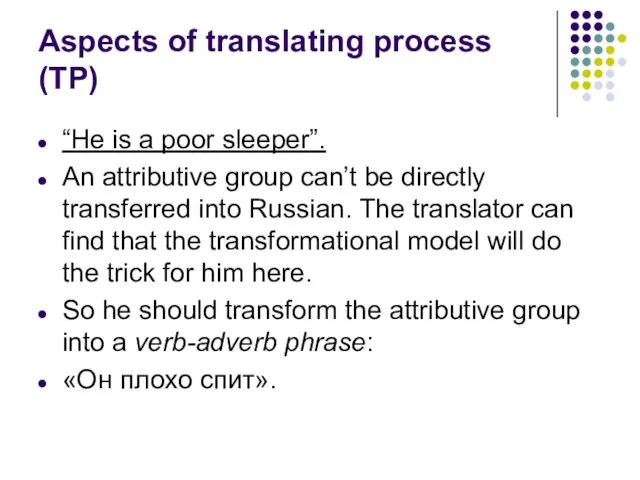
be directly transferred into Russian. The translator can find that the transformational model will do the trick for him here.
So he should transform the attributive group into a verb-adverb phrase:
«Он плохо спит».
Слайд 26Different types of operations performed by the translator:
1) the first group of
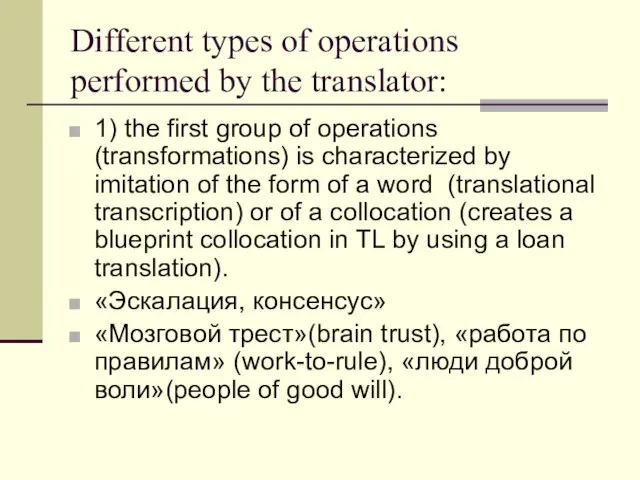
operations (transformations) is characterized by imitation of the form of a word (translational transcription) or of a collocation (creates a blueprint collocation in TL by using a loan translation).
«Эскалация, консенсус»
«Мозговой трест»(brain trust), «работа по правилам» (work-to-rule), «люди доброй воли»(people of good will).
Слайд 27Types of operations performed by the translator
2). The second group of operations
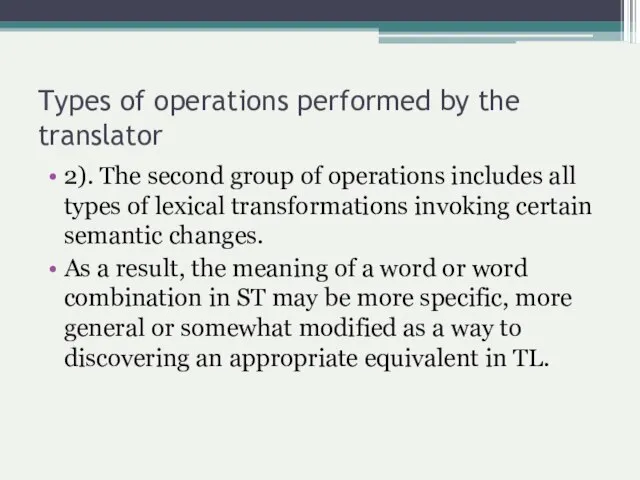
includes all types of lexical transformations invoking certain semantic changes.
As a result, the meaning of a word or word combination in ST may be more specific, more general or somewhat modified as a way to discovering an appropriate equivalent in TL.
Слайд 28Types of operations performed by the translator
The equivalent with a more general
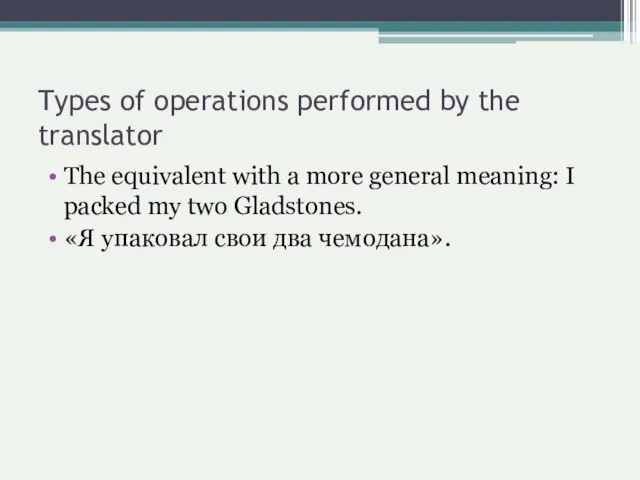
meaning: I packed my two Gladstones.
«Я упаковал свои два чемодана».
Слайд 29Types of operations performed by the translator
3). The third group of translating
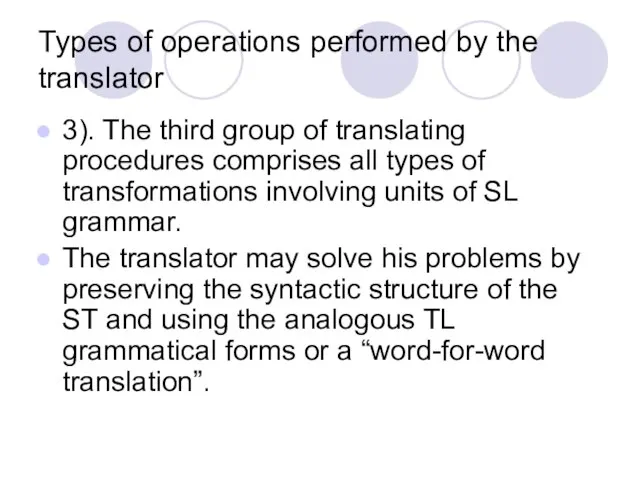
procedures comprises all types of transformations involving units of SL grammar.
The translator may solve his problems by preserving the syntactic structure of the ST and using the analogous TL grammatical forms or a “word-for-word translation”.
Слайд 30Types of operations performed by the translator
John took Mary by the hand.-
Джон
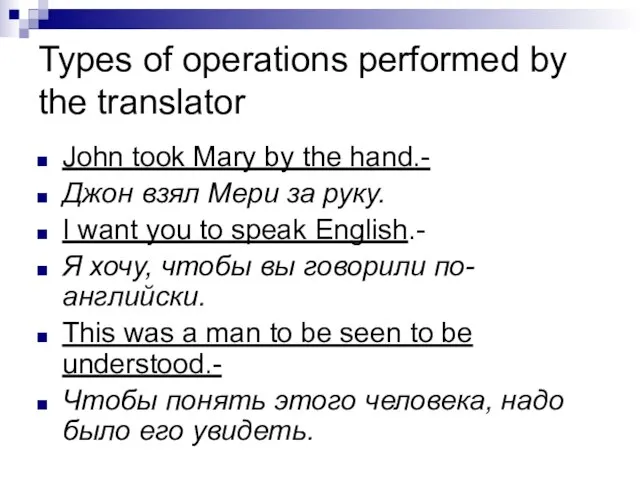
взял Мери за руку.
I want you to speak English.-
Я хочу, чтобы вы говорили по-английски.
This was a man to be seen to be understood.-
Чтобы понять этого человека, надо было его увидеть.
Слайд 31Norm of translation
There are 5 normative requirements which compose the norm of
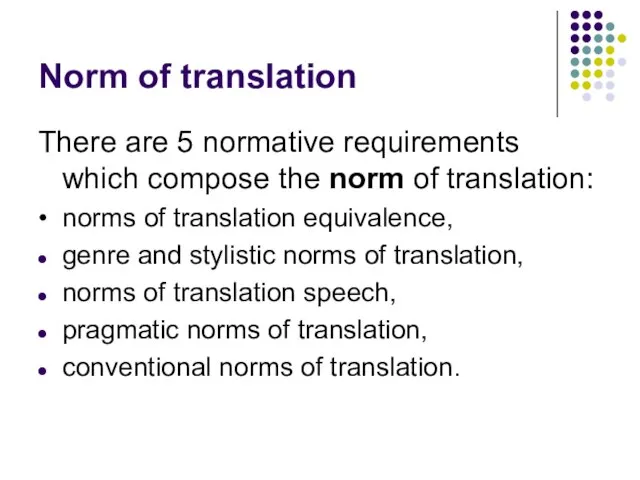
translation:
• norms of translation equivalence,
genre and stylistic norms of translation,
norms of translation speech,
pragmatic norms of translation,
conventional norms of translation.
Слайд 32Translation difficulties
There are 3 types of translation difficulties:
peculiarities of language units semantics,
discrepancies
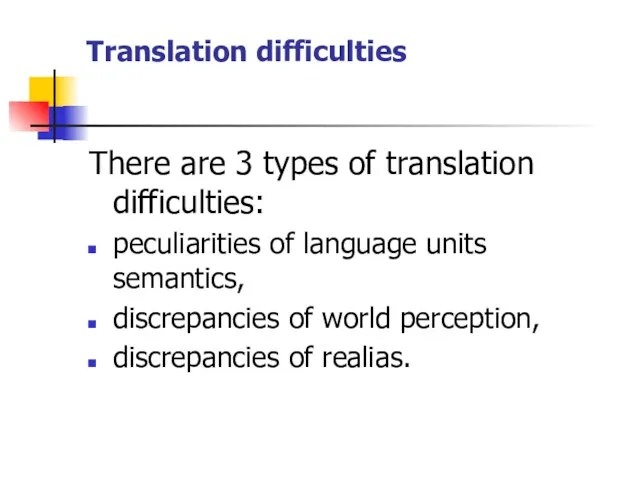
of world perception,
discrepancies of realias.
Слайд 33Methods of research in translation
There are 4 types of comparative analysis used
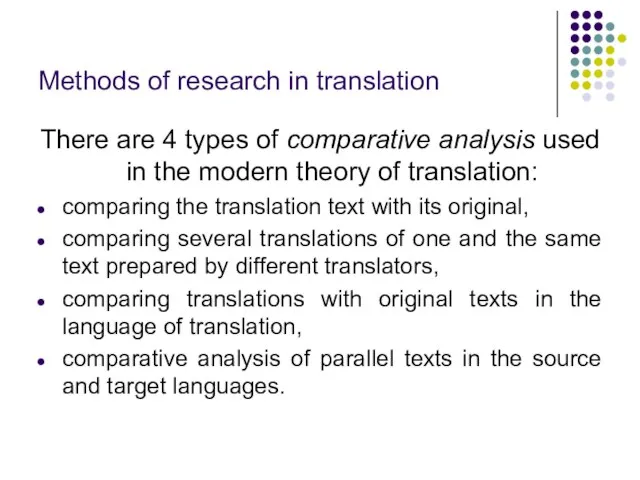
in the modern theory of translation:
comparing the translation text with its original,
comparing several translations of one and the same text prepared by different translators,
comparing translations with original texts in the language of translation,
comparative analysis of parallel texts in the source and target languages.
Слайд 34Questions for the seminar:
Topics for discussion:
1). What is the tr-ing process? What
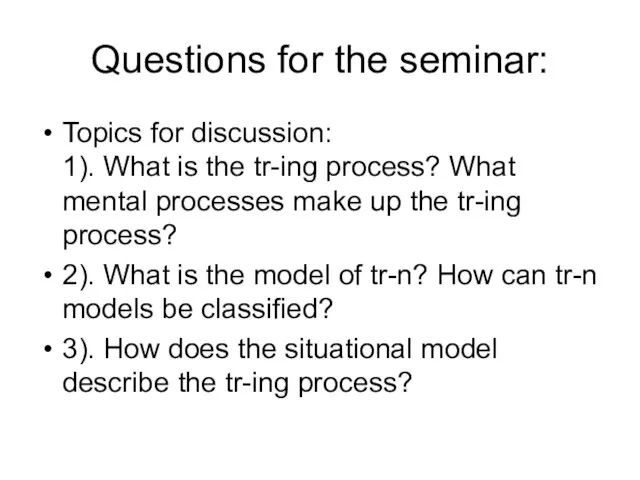
mental processes make up the tr-ing process?
2). What is the model of tr-n? How can tr-n models be classified?
3). How does the situational model describe the tr-ing process?

































 Проект. Будь супер. Будь спорт
Проект. Будь супер. Будь спорт Гера+. Акционное предложение
Гера+. Акционное предложение Крестики – нолики
Крестики – нолики «СИСТЕМА КРИМИНОЛОГИЧЕСКОЙ И ОРГАНИЗАЦИОННО - ПРАВОВОЙ ЗАЩИТЫ БИОРЕСУРСОВ ДАЛЬНЕГО ВОСТОКА».
«СИСТЕМА КРИМИНОЛОГИЧЕСКОЙ И ОРГАНИЗАЦИОННО - ПРАВОВОЙ ЗАЩИТЫ БИОРЕСУРСОВ ДАЛЬНЕГО ВОСТОКА».  Приказ Федерального казначейства «О Порядке открытия и ведения лицевых счетов, открываемых в Федеральном казначействе и территор
Приказ Федерального казначейства «О Порядке открытия и ведения лицевых счетов, открываемых в Федеральном казначействе и территор Презентация на тему Парижское соглашение — соглашение в рамках Рамочной конвенции ООН об изменении климата
Презентация на тему Парижское соглашение — соглашение в рамках Рамочной конвенции ООН об изменении климата  Научно-образовательный портал Science guide
Научно-образовательный портал Science guide Презентация на тему Решение проблемных вопросов, связанных с незаконным перемещением объектов СИТЕС
Презентация на тему Решение проблемных вопросов, связанных с незаконным перемещением объектов СИТЕС  Освоение приемов оклеивания поверхностей стен и потолков обоями
Освоение приемов оклеивания поверхностей стен и потолков обоями 10 прекрасных роз для Вас
10 прекрасных роз для Вас Бухгалтерский учет финансовых вложений
Бухгалтерский учет финансовых вложений  Индустриальное общество в начале ХХ века
Индустриальное общество в начале ХХ века Атмосфера и ее свойства
Атмосфера и ее свойства Вербальные и невербальные средства общения
Вербальные и невербальные средства общения Архитектурный стиль в петровском Петербурге
Архитектурный стиль в петровском Петербурге Направления взаимодействия СРО и банковской ассоциации
Направления взаимодействия СРО и банковской ассоциации Организация предоставления муниципальных услуг
Организация предоставления муниципальных услуг Аминокислоты
Аминокислоты График плавления и отвердевания кристаллических тел
График плавления и отвердевания кристаллических тел Работа стоматологической клиники Astra Dent во время новогодних праздников
Работа стоматологической клиники Astra Dent во время новогодних праздников Презентация на тему ЭКОЛОГИЧЕСКИЕ ПРОБЛЕМЫ СОВРЕМЕННОЙ РОССИИ И ПУТИ ИХ РЕШЕНИЯ
Презентация на тему ЭКОЛОГИЧЕСКИЕ ПРОБЛЕМЫ СОВРЕМЕННОЙ РОССИИ И ПУТИ ИХ РЕШЕНИЯ  И ВЫСОТА
И ВЫСОТА ООО Эрис
ООО Эрис Университет Я. Э. Пуркине Факультет естественных наук Основан 4 ноября 2005 года. Цель факультета - подготовка бакалавров, магистров и
Университет Я. Э. Пуркине Факультет естественных наук Основан 4 ноября 2005 года. Цель факультета - подготовка бакалавров, магистров и О СОСТОЯНИИ ЛЕКАРСТВЕННОГО ОБЕСПЕЧЕНИЯ ОТДЕЛЬНЫХ КАТЕГОРИЙ ГРАЖДАН В ХАБАРОВСКОМ КРАЕ
О СОСТОЯНИИ ЛЕКАРСТВЕННОГО ОБЕСПЕЧЕНИЯ ОТДЕЛЬНЫХ КАТЕГОРИЙ ГРАЖДАН В ХАБАРОВСКОМ КРАЕ Костюм эпохи Средневековья: женский костюм. Лекция 4
Костюм эпохи Средневековья: женский костюм. Лекция 4 Абу-Симбел
Абу-Симбел Презентация без названия
Презентация без названия